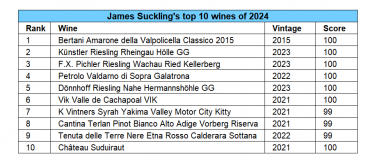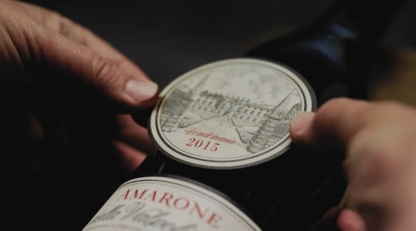- American critic James Suckling has released his top 100 wines of 2024 list.
- His wine of the year is Bertani Amarone della Valpolicella Classico 2015.
- Italy dominates the rankings followed by France and the US.
American critic James Suckling has released his top 100 wines of 2024 list, along with his wine of the year. Each year his team tastes tens of thousands of bottles, releasing comprehensive tasting reports, regional rankings, and ultimately selecting their wine of the year.
For 2024, the top honour went to Bertani Amarone della Valpolicella Classico 2015 – a wine Suckling describes as a perfect expression of “the greatness of time and place.” It received a perfect scoring of 100 points.
This article summarises the key findings from the James Suckling Top 100 and highlights notable regional trends, emerging regions, and value-driven opportunities for collectors.
A record year of tasting: More than 40,000 wines reviewed
James Suckling’s methodology is built on scale. In the past year alone, Suckling and his tasters reviewed more than 40,000 wines, producing hundreds of tasting reports, vintage overviews, and regional analyses. These include everything from everyday wines priced below $20 to rare cuvées from the world’s most prestigious estates.
What makes the James Suckling Top 100 uniquely valuable is that it distills this enormous volume of data into a curated list shaped not only by quality, but also by value, emotional impact, and availability. To be considered, wines must meet key criteria:
-
Minimum production of 5,000 bottles
-
Median release price below $500 (£385)
-
A score typically ranging from 97–100 points
-
A “wow factor” — Suckling’s term for the emotional reaction a wine can provoke
This creates a final list that balances prestige with approachability.
Regional overview: Italy dominates the top spots
While Suckling’s tastings spanned traditional and emerging regions worldwide, Italy once again emerged as the strongest performer. Italian producers submitted more than 9,100 wines for review, slightly surpassing France’s 9,000, and coming ahead of the 6,800 bottles tasted from the United States.
Total wines reviewed in 2024
The countries with the largest representation included:
-
Italy – 9,100 wines
-
France – 9,000 wines
-
United States – 6,800 wines
-
Spain – 3,800 wines
-
Argentina – 2,300 wines
-
Germany – 2,000 wines
-
Australia – 1,700 wines
-
Chile – 1,550 wines
Additional tastings from countries such as Greece, Hungary, Canada, Uruguay, and China
Countries featured in the James Suckling Top 100
Despite fierce global competition, Italy secured 26 positions in the top 100. These included a mix of Amarone, Barolo, Alto Adige whites, Brunello, and Super Tuscan wines. France followed with 18, showcasing a strong lineup of Bordeaux, Champagne, and Rhône releases.
The United States delivered 15 wines to the list, highlighting the continuing excellence of producers in Napa Valley and Oregon. Germany contributed 12 wines, a remarkable showing that underscores its rising profile among critics and consumers alike.
Chile, Australia, Argentina, and Spain all delivered respectable performances, and notably, China secured one place with Ao Yun Shangri-La 2020 – evidence of China’s growing relevance in the fine wine market.
James Suckling’s Wine of the Year: Bertani Amarone della Valpolicella Classico 2015
At the top of the ranking stands Bertani’s Amarone della Valpolicella Classico 2015, a wine that Suckling calls “one of the great Amarones.” Awarded a perfect 100-point score, it showcases deep concentration, complexity, and finesse.
Suckling describes the wine as “full-bodied and elegant, with ripe, filigree tannins, long acidity, and a toasty, savory aftertaste.” Its combination of structure, balance, and aromatic depth makes it a quintessential example of Amarone’s potential when produced in a traditional, long-ageing style.
The selection of an Amarone as the wine of the year reinforces a broader trend: the rising international appreciation for Italy’s great red wines beyond the usual Barolo and Brunello icons.

Value and accessibility: A core theme of the 2024 rankings
Despite the prestige associated with many wines on the list, a significant number of selections in the James Suckling Top 100 fall into surprisingly approachable price brackets. According to Suckling:
-
Nine wines in the Top 100 are priced between $30 and $60
-
Many top-performing whites, including Italian Sauvignon Blancs and Austrian Rieslings, remain accessible
-
Even the second-ranked wine is priced around $65 (£50)
This emphasis on accessibility reflects Suckling’s commitment to highlighting wines that deliver outstanding value, especially at a time when the global wine market is facing both economic pressure and shifting consumer behaviour.
Notable regional highlights
Germany’s breakthrough year
Germany’s outstanding performance – with 12 wines in the Top 100 – confirms the exceptional quality of recent vintages, particularly for dry Riesling. The Künstler Riesling Rheingau Hölle GG 2023 serves as the benchmark, showcasing precision, structure, and aromatic clarity.
Austria’s continued rise
Austria’s representation reflects its steady upward trajectory in global tastings. The wines selected – especially from Wachau – show impressive consistency and terroir expression.
China’s growing presence
The placement of Ao Yun Shangri-La 2020 demonstrates China’s expanding role in the fine wine space. Produced in the foothills of the Himalayas at high elevation, this wine emphasises craftsmanship, innovation, and a distinctive style uncommon in traditional European regions.
What collectors should take away from the 2024 Top 100
The James Suckling Top 100 is more than a “best of” list. It offers insight into:
-
Shifting stylistic preferences
-
Regions delivering strong value
-
Vintages worth buying now
-
Wines with long-term investment potential
-
Global developments beyond traditional wine regions
For collectors and investors, the list serves as a tool for building a diversified cellar, especially at a time when the fine wine market is recalibrating.
Whether your interest lies in high-scoring Amarone, precision-driven Riesling, or ambitious New World expressions, the 2024 rankings provide a highly curated list of wines that blend excitement, accessibility, and long-term promise.
WineCap’s independent market analysis showcases the value of portfolio diversification and the stability offered by investing in wine. Speak to one of our wine investment experts and start building your portfolio. Schedule your free consultation today.

